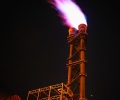U.S. Natural Gas Beats Covid-19

It’s surely going down as the most challenging year ever for the U.S. oil and gas industry. But a solid rebound for shale has been in the works for a few months. WTI crude oil prices, for instance, are now up over $45 per barrel, which is at or even above the breakeven price for many producers and the highest price since early-March.
Yet to be clear, oil’s sister fuel natural gas remains the real fuel of the future. In short, any serious climate policy has more natural gas as a centerpiece strategy.
While U.S. oil demand has been lower this year (at complete stagnation since June, with gasoline use 90% normal and jet fuel 45% normal), gas consumption has been at or even above year-ago levels.
Seemingly unbeknownst to most, U.S. natural gas demand has never really went away through Covid-19 (Figure below), showing its resiliency. For measure, electricity and industry account for ~65% of U.S. gas needs.
Rising 70% from 2009-2019, U.S. natural gas production this year fell 8-9% at the worst of the pandemic. Output is on the rise, however, and is now consistently hitting 90-91 Bcf/d, compared to 93-94 Bcf/d at the end of 2019. Higher prices for both oil and gas in recent months have greatly helped.
And make no mistake, mostly due to optimism around production (because of our massive low-cost resource base), the only gas prices on the futures curve currently above $3.00 per MMBtu is next winter 2021-2022 – for the next 13 years!
The fact is that no energy source can compete with such low commodity prices for gas, especially since we’ve already built a gigantic complex to continually utilize more gas. At some 545,000 MW, 45% of U.S. power generation capacity is natural gas-based, which is more than coal, nuclear, wind, and solar COMBINED.
These are state-of-the-art gas power stations that are built to operate another 40 or 50 years, compared to typically 20 years for wind farms and 30 years for solar. In turn, the truth is that electric cars are more aptly named “natural gas cars.”
Looking forward, a new administration and congress will come face-to-face with this U.S. demand reality of more gas and what I term “buoyantly very high” oil demand (i.e., not necessarily rising but not falling in the absolute sense much either).
I’d be careful: mandates to force more expensive, less convenient electric cars on the American public could easily face major political backlash, especially as the economic justice movement continues to take flight: “Latino Leaders Are Fighting California’s ‘Unbelievably Regressive’ Climate Policies.”
So, the question: what U.S. natural gas market has been impacted by our historic health crisis this year? The answer is our exports of liquefied natural gas (LNG), which have plummeted because of low demand and prices globally.
In 2020, a drastic drop in U.S. LNG exports from January through summer was the primary reason why U.S. gas prices for the first half of 2020 were their lowest since 1989, at $1.80 per MMBtu.
Even globally, the slowdown in rapid LNG growth demonstrates just how difficult this year has been for those in the oil and gas business. For example, only one LNG export project passed a final investment decision (FID) in 2020, Sempra’s Energía Costa Azul liquefaction terminal along the western coast of Mexico in Baja California. At a 3% drop, 2020 is assumed to see the largest recorded decline in global natural gas usage.
Now, U.S. LNG feed gas demand has surged to up over 11 Bcf/d in recent weeks. This is incredibly good news for those of us demanding modern, clean, reliable, and affordable energy for poor people – a moral necessity that has tragically become a complete afterthought.
To illustrate, even though many of their politicians want you to think the opposite, the hard truth is that California, New York, and Massachusetts all enjoy gas-dominated energy systems. This is very telling because they have apparently been doing all that they can to install something different.
Reality check: this year, gas has generated 44% of California’s electricity, 79% of Massachusetts’ electricity, and 41% of New York’s electricity.
I keep warning that as oil and gas demand normalizes, and I can assure that it will, a lack of investment in new supply this year could come back to bite and cause a price spike. Those pushing NOT to invest in new oil supply for whatever reason today might be sowing the seeds of our next recession. I’d argue it’s rather apparent: not investing in commodities that are nowhere near replaceable is a recipe for a disaster.
The U.S. Department of Energy projects that global oil demand (down 8% this year to 92-93 million b/d) will fully rebound to pre-pandemic levels by the end of 2021. Oil and gas meet 70% of U.S. energy demand, so as our economy goes, so goes the need for their supply.
As inventories drain and vaccines start to rollout, we are seeing more and more forecasts for crude even to hit $60 next year for international benchmark Brent, a 50% jump for the average this year.
Indeed, don’t be fooled, lowered oil consumption this year is much more temporal than structural, hardly surprising since oil – still easily the world’s most vital fuel – has no material substitute whatsoever.
The market is showing this as obviously true: energy stocks dominated and rallied 27% in November on the fast coming positive vaccine news.
Source: Forbes

 Hellenic Shipping News Worldwide Hellenic Shipping News Worldwide, Online Daily Newspaper on Hellenic and International Shipping
Hellenic Shipping News Worldwide Hellenic Shipping News Worldwide, Online Daily Newspaper on Hellenic and International Shipping





















 PG-Software
PG-Software